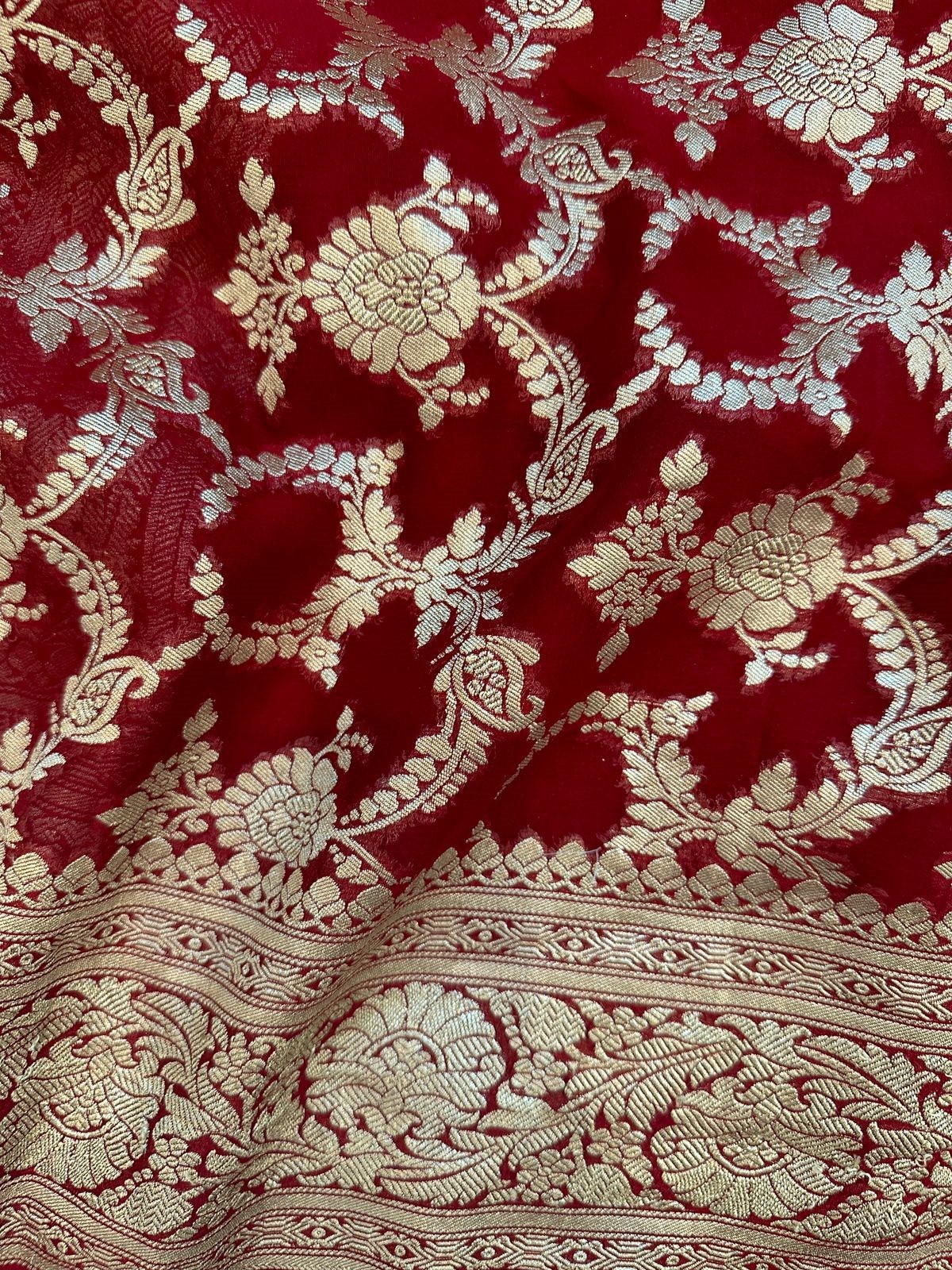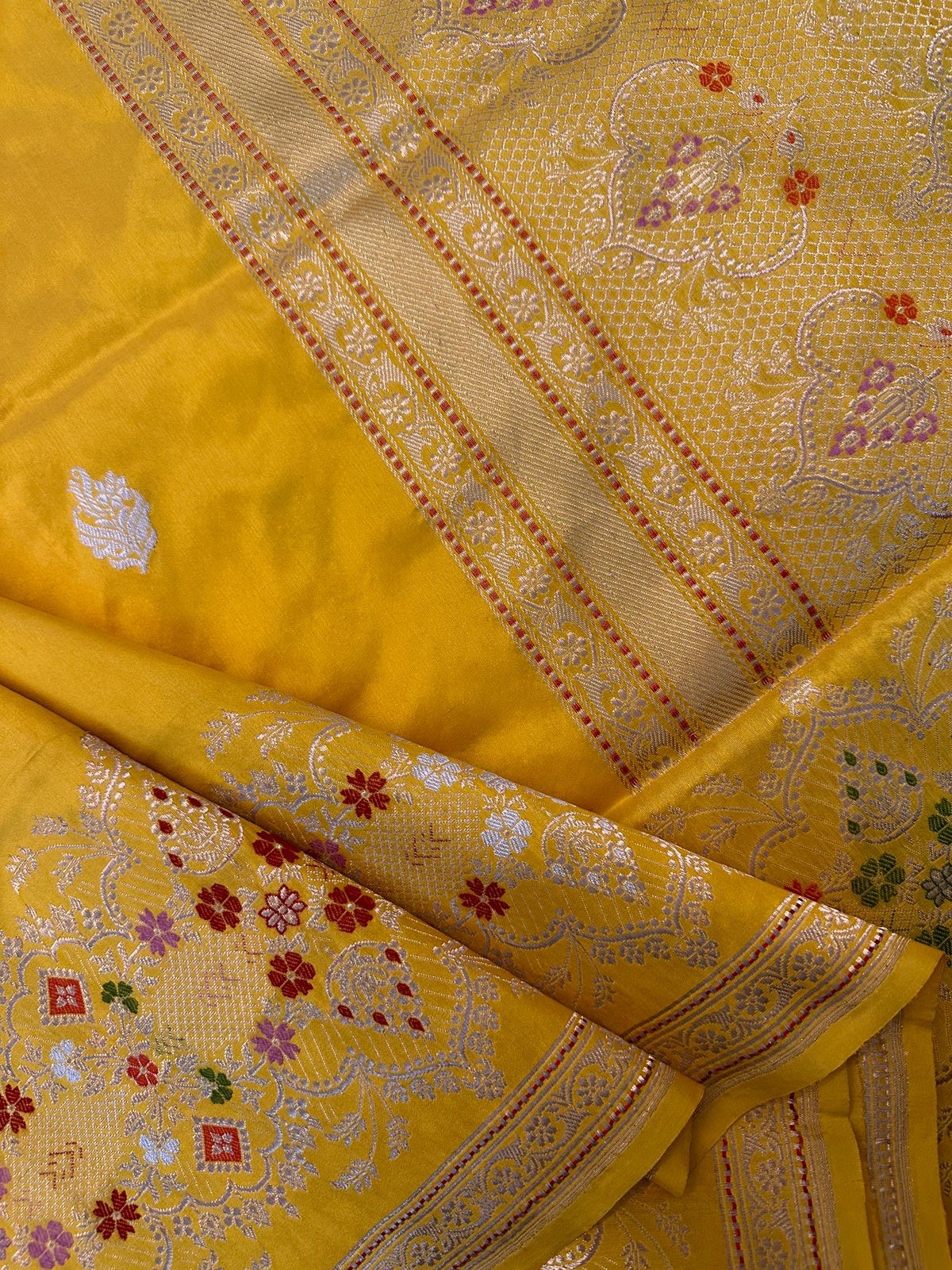The Significance of Motifs and Designs in Banarasi Sarees
May 4, 2023If attire is like a story, then the designs and motifs on it are the storytellers. Since time immemorial, humans have expressed their culture and surroundings through art. And this is also how we know about the history of our culture and nation.
The concept of communicating and telling tales through weaving art is not new. No matter which part of the world you are in, you will learn a lot about its history, culture, and people through art.
Love everything about Banarasi sarees? Well, there is a reason why these age-old draperies remain everyone’s favourite and why they are relevant even after centuries. Have you wondered what the reason is, though?
Banarasi sarees are those gorgeous-looking, supremely beautiful Indian attires that tell a million stories. The sheer richness of these delicacies is unbeaten and makes them a wardrobe mainstay. Banarasi Sarees have sepecial significance in weddings also. Aside from the ultra-rich fabric and weave, the motifs and designs showcased on these sarees are unique and have evolved since the beginning.
You must have grown up admiring your mother and granny’s Banarasi sarees that looked one-of-a-kind and were always state-of-the-art. The surreally beautiful and spectacular designs and motifs on these beauties have a long tale and legacy behind them.
It has much to do with their history and how they evolved with time and trends. If one sets eyes on a yester-year Banarasi saree, their attention would easily be drawn to eye-catching motifs, including bel, paisley, buta, jhalar, and more.
In this blog, we will shed light on the mesmerizingly unique and tasteful motifs and designs that are engraved on Banarasi sarees. These insanely lovely designs are widely appreciated and are also the reason behind the popularity of these delicacies. Let us now learn each one in detail with their meaning and significance. But before we learn more about these designs and motifs, you must know how important is the role of the Mughal era when it comes to Banarasi sarees.
Banarasi sarees get their origin in the holy city of Banaras (present-day Varanasi); however, the motifs and designs showcased are an endearing mix of Indian and Persian designs.
The Banarasi weave was popularised by the Mughal royal family reigning in India centuries ago. And was widely embraced by the women of the royal family. And this is how bel, paisley, buta, jhalar, and several other motifs came into existence.
[Read about Rich Banarasi Weaves And Our Culture]
Floral Buta Motifs

If you have ever set eyes on an age-old Banarasi saree, you will know that the floral buta motifs are a staple. These magnificent floral designs and motifs gained widespread popularity during the Mughal era.
Since Islam discouraged showcasing animal or human figures on sarees, attention shifted towards nature. This is how the floral buta motifs became popular and remain a favourite motif.
Besides being one of the oldest, the floral buta motifs are lovely and immensely loved. They are uniquely placed on Banarasi sarees and are woven using golden and silver zari threads.
These enhance the elegance of these draperies and also offer a tasteful contrast. Banarasi sarees flaunting floral buta motifs always steal the show, be it grand weddings or other celebratory functions!
Paisley Motifs

Banarasi sarees and paisley motifs go hand in hand as there is a lot that these symbolise. Since the beginning of time, these motifs have been used for kings and auspicious occasions.
Like every other motif, there is a meaning and significance to paisley motifs too. Besides being a staple on Banarasi sarees, Gujaratis are known to stamp these motifs outside their houses as it symbolise fertility.
Other than fertility and generations, paisley motifs also indicate spiritual and economic importance. Aside from Banarasi sarees, these lovely paisley motifs are also found on Kanchipuram, Buttidar Baluchi, and Dhakai Jamdanis sarees.
Floral Jaal Motifs

We cannot speak of Banarasi sarees without mentioning the enchanting floral jaal motifs. Flowers hold great significance and meaning in our nation. Since the beginning of time, flowers and other nature-centric motifs have been prevalent in our nation. There is hardly any occasion in our country that is complete without flowers.
Floral designs were introduced by the weavers of Gujarat when they first came to Banaras; however, it was popularised in the Mughal era.
The adoration that the royals had for flowers and nature led to floral jaal motifs becoming a staple on Banarasi sarees. Other than offering the wearer a refined look, the floral jaal motifs symbolize love, success, happiness, joy, and fertility.
Bel Buti Motifs

Besides paisley and floral jaal motifs, one of the most renowned designs on Banarasi sarees is the bel buti motif. These timeless motifs are rooted in Persia and are symbolic of the beautiful nature around us. The bel patterns beautifully showcase small and large butis and butas on them, which are flowers.
They are another fondly appreciated pattern and are widely used in Banarasi sarees. It is finely engraved on these delicacies by weavers to create geometric patterns. The use of different colours further enhances the charm of this spectacular motif.
[Read About The Roots Of Banarasi Sarees]
Konia Motifs

Another prominent motif that is found on Banarasi sarees is the Konia motif. These designs are finely-crafted mango-shaped motifs woven using gold or silver threads. These symbolize richness, prosperity, and abundance. All the Banarasi sarees flaunt Konia motifs between the border and the pallu.
These look exceptionally beautiful and tasteful, forming a significant part of the Banarasi saree weaving industry. The utter charm that these motifs offer to the saree is unmatched.
Shikargah Motifs

Shikargah motifs are undeniably unique designs found on a Banarasi saree. Shikar means hunting, and such sarees represent hunting scenes on them. It includes nature, plants, animals, and various other elements. Such sarees are rich and heavy as they depict hunting scenes. It is believed that such motifs were introduced in Persia.
[Read about Banarasi Art From The Golden Age]
Bird Motifs

Bird motifs are also special type of motifs created on banarasi sarees. Ancient designs featured flying peacocks and parrots as motifs, however, as art evolved, minimalistic bird designs are now used in contemporary styles. The eye-catching bird motifs are of a modern design, but they are made more distinctive and appealing by using the ancient kadwa weaving technique.
Finally
Besides the motifs and designs Anvisha - Pure Banarasi Saree Manufacturer explained above, there are various other gorgeous patterns. With evolving times, countless contemporary patterns and motifs have also emerged. These cater to the preferences and tastes of modern-age women and make Banarasi Sarees popular among new age women. Flaunt magnificent Banarasi sarees that tell a million stories.






 Call Us Now
Call Us Now
Comments For This Post